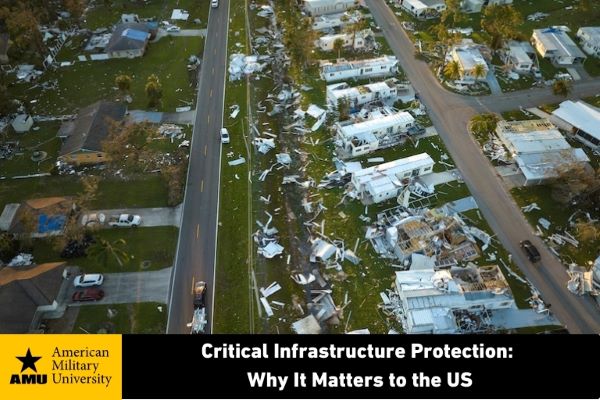By Dr. Jarrod Sadulski | 05/30/2025

Critical infrastructure protection is essential, as we depend on various services to keep us healthy and safe. Protecting critical infrastructure sectors ensures the stability and security of daily life in the United States.
What Is Critical Infrastructure?
Critical infrastructure can include nearly anything the public and government rely on. Critical infrastructure also includes various systems and assets, including:
- Gas pipelines
- Government agencies
- Water treatment facilities
- Information technology networks
- Healthcare and public health facilities
- Electrical and nuclear power plants
These high-value sectors are vital to national defense, economic security, and public health.
The financial services sector also qualifies as critical infrastructure. Financial services depend on both physical safeguards and cyber defenses to manage risks and maintain security.
The protection of national infrastructure requires coordination between government agencies and civilian stakeholders. Together, they must proactively manage the risks across industries – especially in areas like financial markets that are frequent targets for both foreign and domestic threat actors.
Ongoing Threats to Essential Systems
Every day, critical infrastructure assets face threats. Whether it is homeland security facilities, the public health sector, or emergency services, the risks are real and increasing. For example, critical infrastructure projects such as industrial control systems – like water treatment facilities that control drinking water – are often targeted.
Cyber threats are especially common and include tactics like denial-of-service attacks, Man-in-the-Middle (MitM) attacks, and ransomware. Data acquisition is another tactic used by cybercriminals targeting national and economic security.
Risk Management
Organizations responsible for protecting high-value industries and national infrastructure include both the federal government and the private sector. They must collaborate through strong partnerships to guard against attacks that could impact critical services like hospitals, the Centers for Disease Control (CDC), and electronic health records.
Because potential threats can take many forms, including physical security attacks and cyber threats, frequent and thorough vulnerability assessments are essential to identify and monitor these threats. Once threats are identified, a national infrastructure protection plan (such as the National Infrastructure Protection Plan created by the Department of Homeland Security) and national infrastructure assurance plan can be developed. These plans should include incident response strategies to address attacks or disasters swiftly and effectively.
Risk management is also key to securing critical infrastructure and safeguarding national economic security. A strong approach to infrastructure protection mitigates significant risks and helps ensure that essential services are not disrupted.
A major attack on United States infrastructure could also impact global economies. That is why sharing information with the U.S., our allies, and the private sector is so important.
Additional Threats to Critical Infrastructure Security and Resilience
Beyond cyberattacks, human error and equipment failure also pose risks to areas such as network security and healthcare security. Operational technology (OT) systems are also vulnerable. Their operators must remain informed with the latest threat intelligence to reduce the risk of disruption.
Disasters, Incident Response, and Climate-Related Challenges
Natural disasters can cause major problems for critical infrastructures. Events like hurricanes, earthquakes, and flooding often occur with little warning and pose ongoing challenges to infrastructure resilience.
For example, imagine that a major hurricane passes through a community, causing devastating consequences. This type of natural disaster typically damages not only homes, churches, and schools, but also bank buildings and post offices. It also can damage water treatment plants, hospitals, and electrical utility systems.
Increased attention and growing concerns about climate change suggests these types of events may become more severe and more frequent. As a result, it is wise to make extensive contingency plans so that communities may have effective protection and recover more quickly.
Planning for the Unexpected
Protecting critical infrastructure from natural and human-made threats requires proactive contingency planning. A strong critical infrastructure protection (CIP) involves providing clear procedures, policies, and steps that critical infrastructure sector personnel can take before an attack or emergency occurs.
An effective CIP strategy ensures continued operation of services that are essential for public health and safety.
Community Involvement in Security Efforts
While we depend on the government and private stakeholders to protect critical infrastructure, community members also play an important role and have a responsibility to protect their own infrastructures. Reporting suspicious activity or any signs of radical terrorist can also help prevent attacks.
Security and resilience are critical for the well-being of our nation’s physical infrastructure, and public awareness is a vital element in critical infrastructure security.
Homeland Security Degrees at AMU
For adult learners who are interested in learning how to improve their knowledge of critical infrastructure security, homeland security, and other related topics, American Military University (AMU) offers a set of degrees:
Taught by expert instructors with a deep understanding of homeland security, courses in these programs discuss topics such as critical infrastructure protection, border and coastal security, and intelligence and homeland security. Other courses include domestic terrorism and extremist groups and resilience and homeland security. Students can also choose from one of eight concentrations to gain the knowledge that meets their professional goals.
For more information, visit our homeland security degree program page.

Dr. Jarrod Sadulski is an associate professor in the School of Security and Global Studies and has over 20 years in the field of criminal justice. He holds a bachelor’s degree in criminal justice from Thomas Edison State College, a master’s degree in criminal justice from American Military University, and a Ph.D. in criminal justice from Northcentral University.
His expertise includes training on countering human trafficking, maritime security, mitigating organized crime, and narcotics trafficking trends in Latin America. Jarrod has also testified to both the U.S. Congress and U.S. Senate on human trafficking and child exploitation. He has been recognized by the U.S. Senate as an expert in human trafficking.
Jarrod frequently conducts in-country research and consultant work in Central and South America on human trafficking and current trends in narcotics trafficking. Also, he has a background in business development.
